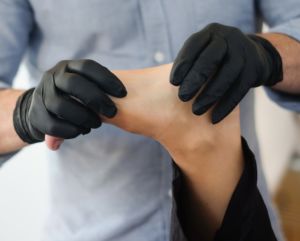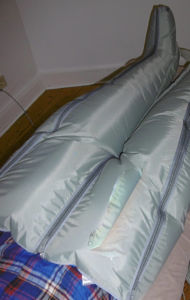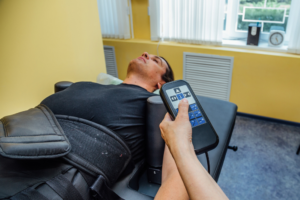
Sports injuries can be frustrating. They interfere with daily life and keep you away from the activities you love. Going back too soon can lead to further injury and more time out of the game. So how can you speed recovery and get back to being yourself?
Here at Vanguard Spine and Sport, we specialize in treating sports injuries. Here are six treatment options that can relieve your pain and speed healing.
1. Kinesiotherapy
Kinesiotherapy, also known as physiotherapy, is one of the treatments we offer to our sports injury patients at our Houston clinic. Our licensed kinesiotherapists use active and passive movement techniques (stretches, exercises, and massage) to help heal soft tissue. They also work with our patients to design personalized exercise regimens that build back muscle strength and increase mobility without causing further pain or injury. Kinesiotherapy can be used from your first day of treatment all the way through recovery.
When you are on the road to recovery, exercising appropriately is the key to not losing ground. Our therapists will make sure you understand what types of movement your body can handle and what things you should stay away from for a while. They will work with you to meet your recovery and fitness goals.
2. Chiropractic Adjustment
Chiropractic adjustment isn’t just for your spine. Our chiropractors can work on any injured joint to help relieve pain and inflammation and restore range of motion. Chiropractic adjustment can focus on one area or be used as a whole-body treatment.
When the spine is in optimal alignment, the nervous system and immune system function better, and the body can heal more effectively. Even if your injury is not directly affecting your spine, your chiropractor might work on your spine in addition to the injured area. The goal is to restore balance and optimal functioning.
3. Active Release Technique (ART)
The Active Release Technique was invented in 1984 by a chiropractor who wanted better, quicker outcomes for his injured patients. He noticed that ongoing pain and limited range of motion were caused by changes in the soft tissues around the injured area.
During an active release treatment, the practitioner applies precise pressure to the soft tissues while the patient moves the muscle from a shortened to a lengthened position. The goal is to break up scar tissue that is binding muscles, ligaments, and nerves. Once the excess scar tissue is gone, a normal range of motion can be restored.
Many athletes who experience injuries find that their performance suffers even after they heal. ART can be used on old injuries as well as newer ones to restore the natural range of motion and reduce discomfort.
Enter, CC BY-SA 4.0 <https://creativecommons.org/licenses/by-sa/4.0>, via Wikimedia Commons
4. NormaTec Recovery
As an athlete, you have probably used the RICE method to treat minor to moderate sports injuries. One of the most important components of the RICE method is compression. Compression reduces swelling and the build-up of lymph fluid and allows for free blood flow to the injury. Better blood flow means more oxygen and nutrients and faster healing.
Here at Vanguard, we use the NormaTec recovery compression system. A physician bioengineer designed this state-of-the-art compression gear. It uses dynamic air pressure to mimic the pump of leg and arm muscles, enhancing the movement of fluids out of the muscle.
Our patients use NormaTec compression gear to help them recover after an injury and as a part of their workout routine. Using compression before and after working out can aid warm-up and recovery, reducing the chance of injury.
5. Spinal Decompression Therapy
Herniated discs and whiplash injuries can happen as the result of a hard tackle or an awkward fall. Decompression therapy can effectively treat these problems and get you pain-free again.
Decompression therapy uses motorized tables that move your body into the precise position that creates negative pressures between your vertebrae. The negative pressure acts as a vacuum to suck in bulging and herniated discs and relieve pressure on nerves. It also increases blood flow to the injured area.
The procedure is non-invasive and comfortable. After a full regimen of treatments, over 85% of patients experience lasting relief from their neck or back pain.
6. Cryotherapy
Cryotherapy uses extreme temperatures to trigger a systemic anti-inflammatory response. It was originally used to treat rheumatoid arthritis and other painful inflammatory conditions. When used to treat injuries, it has been found to decrease recovery time by 50%.
It may sound strange that exposing yourself to freezing temperatures could be good for your health, but science backs the use of cryotherapy for inflammatory conditions. When your body is exposed to very cold temperatures, it tries to keep itself warm by increasing blood flow. This increased blood flow helps to clean up lactic acid and inflammation and exposes injured areas to more oxygen and nutrients. Since inflammation is often responsible for pain, cryotherapy can also be helpful for pain management.
Cryotherapy is safe when administered by professionals. The patient enters a cryochamber that exposes them to freezing bursts of air. They can communicate at any time with a technician if they feel uncomfortable. Cryotherapy sessions last between 2 to 5 minutes, so they are convenient to fit into a treatment schedule. Most people don’t experience any side effects, but your skin may feel slightly irritated for a day or two after treatment if you are sensitive to cold. Like all treatments, cryotherapy is not appropriate for everyone. Let your provider know if you have any health conditions like diabetes or heart problems or if you are pregnant.
Your Treatment Plan
The treatments outlined above are just some of the therapies we use for our sports injury clients. Our providers will diagnose your injury and create a personalized treatment plan that will help you heal quickly and completely.







